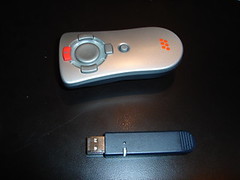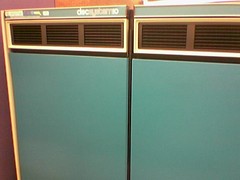18 July 2005
Cringely on Intel/Apple
Another, more conspiratorial take on the Apple/Intel alliance. I tend to lean towards the simpler explanation, but then, without conspiratorial theories guys like Cringely wouldn't have a job.
30 June 2005
podcasting goes mainstream
Podcasting is one of those simple ideas that doesn't really seem like much until you think about it, and then you realize it's pretty revolutionary. But up to now, it's required finding and installing new software, much of it not very well developed. But now that iTunes 4.9 provides direct support for podcasting, and now that established media outlets are providing content (my favorite is http://www.kcrw.org/podcast/) it's poised to take off quickly.
07 June 2005
Intel on the Mac
It makes sense. Mostly it's about the power consumption to processing ratio - the PowerPC simply isn't keeping up.
It's a bit sad and scary to see Intel take one more niche (Sun next?) but it seems like the right decision for Apple.
It's worth watching Jobs' keynote presentation at the Apple Developer's Conference, to hear him explain his reasoning and the transition plan. Besides, it's always fun watching a master showman. He reveals that Apple has been building OSX for Intel for the last five years, "just in case". He describes what it will take for developers to create a "universal binary" that will run on both processor platforms, and demos a dynamic binary translator ("Rosetta") that will run PowerPC apps on the Intel platform.
Almost none of this is about OSX running on non-Apple platforms (which Apple will certainly discourage) or Windows running on Apple platforms (which Apple will allow and might be an incremental plus from the transition). I believe the party line on this - it's about Apple choosing the best processor technology going forward.
It sounds like Apple has a good plan, let's hope they can execute.
It's a bit sad and scary to see Intel take one more niche (Sun next?) but it seems like the right decision for Apple.
It's worth watching Jobs' keynote presentation at the Apple Developer's Conference, to hear him explain his reasoning and the transition plan. Besides, it's always fun watching a master showman. He reveals that Apple has been building OSX for Intel for the last five years, "just in case". He describes what it will take for developers to create a "universal binary" that will run on both processor platforms, and demos a dynamic binary translator ("Rosetta") that will run PowerPC apps on the Intel platform.
Almost none of this is about OSX running on non-Apple platforms (which Apple will certainly discourage) or Windows running on Apple platforms (which Apple will allow and might be an incremental plus from the transition). I believe the party line on this - it's about Apple choosing the best processor technology going forward.
It sounds like Apple has a good plan, let's hope they can execute.
03 June 2005
Sometimes, it just works!
This is a Presentation Pilot (tm) Pro, sold by Interlink Electronics. It lets you control a PowerPoint presentation. To use it, you plug in a USB dongle, press one button, and then you can change slides up to 50' away via the 2.4 GHz spectrum. No software install, no set up, just plug it in, turn it on, and go. It fits comfortably in your hand, it's light, it looks great, and it just works. It's wonderful when people get it right.
20 May 2005
25 years in information technology
This disk drive holds 2.2 billion bytes of data. I bought it at Fry's the other day for $100.
The computer below is a Decsystem 10, state-of-the-art in 1979. Each of the aqua boxes is roughly the size of a Sub-Zero fridge. This system probably had something like 512 kbytes of solid-state RAM and 50 megs of disk storage, and sold for several million dollars. I took the picture at the Computer History Museum in Mountain View a couple of weeks ago.
In 1979, I worked for a company called Tymshare and this was one of their computers, so most likely I used it. Tymshare rented out time on computers that it owned, and you could rent time on a Decsystem 10 for a few hundred dollars an hour.
While I was working at Tymshare, IBM announced their PC was on the way. All the young guys like me figured "game over" for Tymshare, but it took about 3 or 4 years for Tymshare's business model to implode. Things moved slower in those days.
The Decsystem 10 was a fine computer. It ran an operating system called TOPS-20 which had the best command-line interface I've ever used. If you know what a command-line interface is, you're either old or run Linux.
The computer below is a Decsystem 10, state-of-the-art in 1979. Each of the aqua boxes is roughly the size of a Sub-Zero fridge. This system probably had something like 512 kbytes of solid-state RAM and 50 megs of disk storage, and sold for several million dollars. I took the picture at the Computer History Museum in Mountain View a couple of weeks ago.
In 1979, I worked for a company called Tymshare and this was one of their computers, so most likely I used it. Tymshare rented out time on computers that it owned, and you could rent time on a Decsystem 10 for a few hundred dollars an hour.
While I was working at Tymshare, IBM announced their PC was on the way. All the young guys like me figured "game over" for Tymshare, but it took about 3 or 4 years for Tymshare's business model to implode. Things moved slower in those days.
The Decsystem 10 was a fine computer. It ran an operating system called TOPS-20 which had the best command-line interface I've ever used. If you know what a command-line interface is, you're either old or run Linux.
18 May 2005
Games of Death and Life
Yesterday I watched Bas Verhart, CEO of Media Republic in Amsterdam demo two of their games. Killzone, a first-person shooter, is being published by Sony for the new Playstation. It has stunning photorealistic graphics with ultra violence and neo-Nazi overtones. Ironically, the presentation followed a discussion of ethics in game design and alternatives to violence, and Bas gave a few nervous chuckles as the demo proceeded, finally cutting it off in the middle of a scene showing kneeling prisoners being executed with head shots.
Next he showed us Eccky, an online game where two players create a "virtual child". The child combines the "DNA" of the two "parents" as determined by the results of filling out a questionnaire, combined with some randomness. The children cry and nag you to buy things for them, allowing for nice commercial tie-ins on which the business model is built. You can also have the dubious pleasure of having your "child" SMS you if you're not giving him or her enough attention.
This is online design in 2005.
Next he showed us Eccky, an online game where two players create a "virtual child". The child combines the "DNA" of the two "parents" as determined by the results of filling out a questionnaire, combined with some randomness. The children cry and nag you to buy things for them, allowing for nice commercial tie-ins on which the business model is built. You can also have the dubious pleasure of having your "child" SMS you if you're not giving him or her enough attention.
This is online design in 2005.
Subscribe to:
Posts (Atom)







